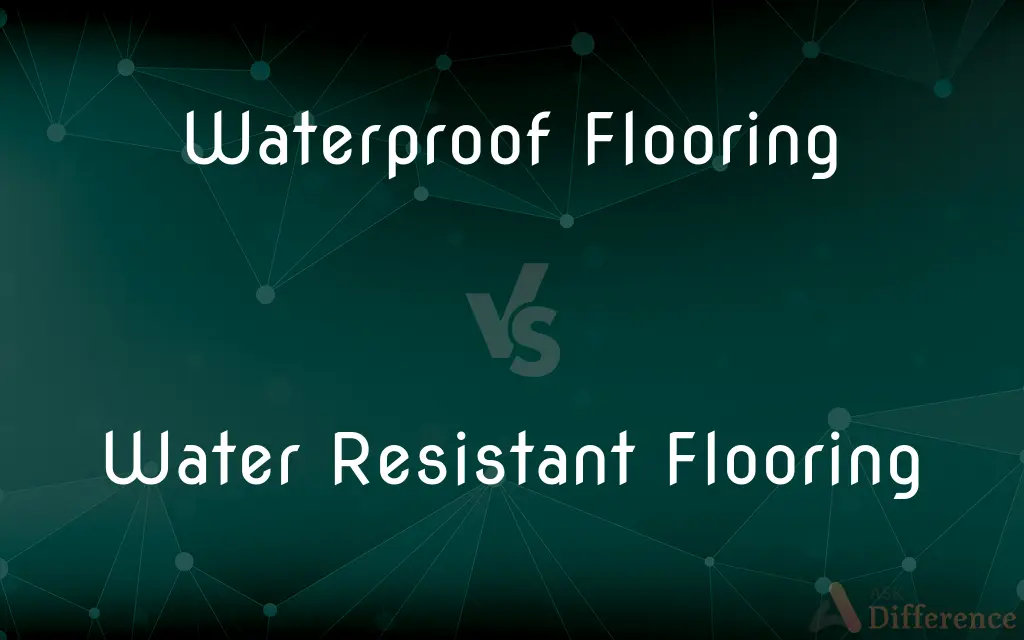Waterproof Flooring vs. Water Resistant Flooring — What's the Difference?
By Maham Liaqat & Urooj Arif — Published on May 11, 2024
Waterproof flooring can completely block water penetration, ideal for bathrooms and kitchens, while water-resistant flooring delays water damage but eventually absorbs moisture.

Difference Between Waterproof Flooring and Water Resistant Flooring
Table of Contents
ADVERTISEMENT
Key Differences
Waterproof flooring is designed to prevent water penetration entirely, making it an excellent choice for areas exposed to high moisture levels like bathrooms and kitchens. On the other hand, water-resistant flooring is treated to resist water penetration up to a certain point, making it suitable for areas with occasional spills.
While waterproof flooring can be submerged in water without suffering damage, ensuring its integrity over time, water-resistant flooring can only fend off water for a limited duration before the moisture begins to seep through, potentially causing damage.
Waterproof flooring materials, such as vinyl and ceramic tiles, are constructed to withstand moisture and water exposure without warping or staining. Conversely, water-resistant flooring materials like laminate and some hardwoods offer temporary protection against moisture, but prolonged exposure can lead to swelling and damage.
Installation of waterproof flooring typically requires more specialized materials and techniques to ensure a completely moisture-proof barrier. In contrast, water-resistant flooring can be easier and less costly to install, with fewer constraints on underlayment and adhesives.
Maintenance of waterproof flooring is generally straightforward, often requiring only regular cleaning to maintain its appearance and functionality. However, water-resistant flooring may require more meticulous maintenance to prevent water damage, including immediate cleanup of spills and avoiding the use of excessive water during cleaning.
ADVERTISEMENT
Comparison Chart
Moisture Barrier
Complete protection
Temporary resistance
Ideal Use
Bathrooms, kitchens
Areas with occasional spills
Material Examples
Vinyl, ceramic tiles
Laminate, some hardwoods
Installation
Specialized techniques
Easier, less costly
Maintenance
Simple, regular cleaning
Careful cleanup of spills
Compare with Definitions
Waterproof Flooring
Requires minimal maintenance to keep its waterproof properties.
A simple mop is sufficient to clean waterproof flooring, keeping it in good condition.
Water Resistant Flooring
Materials include a protective layer to fend off moisture.
Engineered wood flooring has a water-resistant top layer that helps protect against spills.
Waterproof Flooring
Designed to prevent water damage entirely.
Waterproof ceramic tiles maintain their appearance, even in high-moisture areas.
Water Resistant Flooring
Not recommended for areas with constant water exposure.
Using water-resistant flooring in a bathroom requires caution and regular maintenance.
Waterproof Flooring
Ideal for areas prone to water exposure.
Installing waterproof flooring in the kitchen can prevent water damage from spills.
Water Resistant Flooring
Requires more maintenance to extend its resistance to water.
Sealants can enhance the water-resistant properties of hardwood flooring.
Waterproof Flooring
Made from materials that do not absorb water.
Rubber waterproof flooring offers a durable, moisture-proof surface for basements.
Water Resistant Flooring
Flooring that can resist water penetration to a degree but not indefinitely.
Laminate flooring is water-resistant, making it suitable for living rooms.
Waterproof Flooring
Flooring that provides complete protection against water penetration.
Vinyl waterproof flooring is perfect for a bathroom remodel.
Water Resistant Flooring
Offers temporary protection against spills.
Water-resistant hardwood flooring should be wiped immediately after spills to prevent damage.
Common Curiosities
What is water-resistant flooring?
Flooring that offers temporary protection against water, suitable for areas with occasional spills.
What is waterproof flooring?
Flooring that completely blocks water from penetrating, making it ideal for high-moisture areas.
Can water-resistant flooring be used in bathrooms?
It can be used but requires caution and immediate cleanup of water to prevent damage.
Is waterproof flooring more expensive than water-resistant flooring?
Generally, yes, due to its comprehensive moisture protection and installation requirements.
Can laminate flooring be considered waterproof?
Laminate flooring is typically water-resistant, not waterproof, as it can absorb water over time.
Does water-resistant flooring need to be sealed?
Sealing can enhance its resistance to water, but it depends on the material and installation area.
Can water-resistant flooring be made more resistant to water?
Yes, through the application of sealants and choosing materials with better resistance properties.
How do you clean waterproof flooring?
With regular sweeping and mopping, using mild cleaners to maintain its appearance.
How long does water-resistant flooring resist water?
It varies by material but generally can resist spills for a few hours before damage occurs.
How does humidity affect water-resistant flooring?
High humidity can reduce its effectiveness over time, leading to potential swelling and warping.
What are the main benefits of waterproof flooring?
Durability in wet conditions, low maintenance, and protection against water damage.
What maintenance does water-resistant flooring require?
Immediate cleanup of spills and occasional application of protective sealants.
Are there any downsides to waterproof flooring?
It can be more expensive and may have fewer aesthetic options than traditional flooring.
Is vinyl flooring waterproof or water-resistant?
Vinyl flooring can be either, but most modern vinyl options are designed to be waterproof.
Can waterproof flooring be installed anywhere in the house?
Yes, it is versatile enough to be used in any room, including basements and laundry rooms.
Share Your Discovery

Previous Comparison
Booster Pump vs. Pressure Pump
Next Comparison
Calcium Citrate Malate vs. Calcium CarbonateAuthor Spotlight
Written by
Maham LiaqatCo-written by
Urooj ArifUrooj is a skilled content writer at Ask Difference, known for her exceptional ability to simplify complex topics into engaging and informative content. With a passion for research and a flair for clear, concise writing, she consistently delivers articles that resonate with our diverse audience.













































